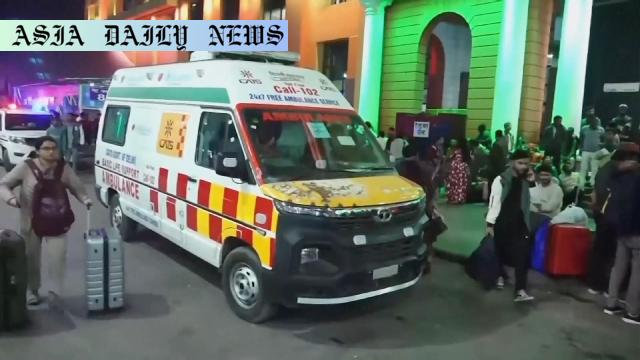Stampede kills at least 15 people at a New Delhi railway station amid chaos during a major Hindu festival.
- Stampede at New Delhi railway station killed at least 15 people, including three children.
- Passengers were heading to Prayagraj for the Hindu Kumbh Mela festival.
- Prime Minister Modi expressed condolences and urged speedy recovery for the injured.
- This is the second deadly stampede linked to the festival since January.

Tragic Incident at New Delhi Railway Station
A catastrophic stampede occurred at a New Delhi railway station on Saturday evening, claiming the lives of at least 15 individuals, including three children. The railway platform was overcrowded as pilgrims prepared to board a train to Prayagraj for the Kumbh Mela festival, a major Hindu religious event that has drawn millions of participants.
Overcrowding and Festival-Related Chaos
The incident highlights the challenges of managing large crowds during cultural and religious events in India. The Kumbh Mela festival, which began in January, sees an estimated 400 million Hindu devotees gathering to bathe in the Ganges River, believing it to purify their sins. Such gatherings are not uncommon in India, but the combination of limited infrastructure and overwhelming numbers can lead to precarious situations, as tragically demonstrated in this case.
Response from Authorities
Prime Minister Narendra Modi conveyed his condolences via social media, stating, “My thoughts are with all those who have lost their loved ones. I pray that the injured have a speedy recovery.” Authorities have been urged to implement stricter safety measures, particularly at festival sites and transit hubs. This tragic incident follows another stampede during the Kumbh Mela on January 29, which resulted in over 30 fatalities on the banks of the Ganges River.
Calls for Improved Safety Measures
The recurrence of such fatal incidents raises concerns about safety protocols enforced during large religious or public gatherings. Experts and social activists have long emphasized the need for better crowd management systems, clear communication pathways, and robust on-ground monitoring teams to prevent accidents. Despite these calls, incidents continue to occur, emphasizing the urgent need for systemic reform.
Lessons from Tragedies
Historically, religious festivals in India have faced safety issues. The lessons from such tragedies extend beyond religious settings to any public gathering, requiring a more focused approach to public safety and crowd management. Ensuring better transport mechanisms, increasing the number of specialized safety personnel, and leveraging technology to manage crowds can be potential solutions to mitigate such disasters in the future.
Support for the Affected Families
As families mourn their loss, NGO workers, local officials, and community leaders have offered support and aid to those affected by the stampede. Many advocate for government compensation for the victims’ families, as well as improved policies prioritizing safety for all citizens. It is imperative to adopt a multi-level approach involving policy, technology, and education to prevent future tragedies.
The Way Forward
This devastating incident serves as a sobering reminder of the need for systemic improvements in crowd management, particularly during high-profile events attracting large gatherings. With increased public awareness and governmental intervention, India can aim to avert similar occurrences and enhance safety measures for the future.



Commentary
Reflections on the Tragedy
The tragic stampede at New Delhi railway station is a stark reminder of the dangers posed by overcrowding and poor safety protocols in high-traffic public spaces, particularly during significant cultural or religious events. The scale of the loss—15 lives, including young children—is heartbreaking, and the incident raises critical questions about planning, management, and accountability.
Addressing Recurring Patterns
One concerning aspect of this incident is that it is not an isolated event. The Kumbh Mela festival, like many other large gatherings in India, has witnessed similar tragedies in the past. The repeated occurrence of such disasters indicates systemic gaps in crowd management and infrastructure readiness. This particular tragedy underscores the pressing need for authorities to treat public safety with greater urgency.
A Call for Action
While condolences have been extended by prominent leaders, including Prime Minister Modi, words alone are not enough. This tragedy must serve as a wake-up call for comprehensive reforms, not only in managing high-profile festivals but also in improving daily travel infrastructure across the country. Investing in crowd-control technologies, training personnel, and ensuring emergency response preparedness could significantly reduce the likelihood of such disasters in the future.
Empathy for the Victims
As we contemplate the broader lessons, it is essential not to overlook the immense pain and suffering endured by the victims and their families. Their loss is immeasurable, but collective action—through donations, legal advocacy, or grassroots activism—can serve as a step toward ensuring such tragedies are not repeated. This event should not become just another statistic but a catalyst for meaningful change.